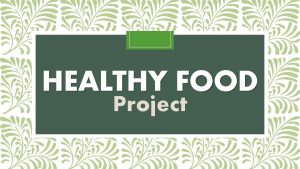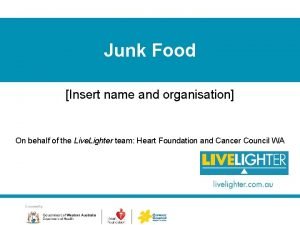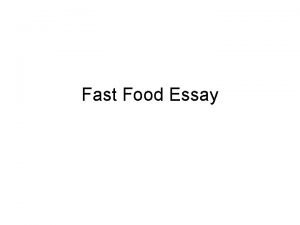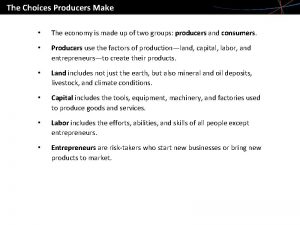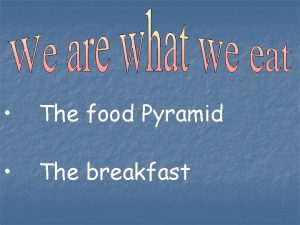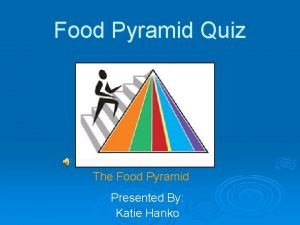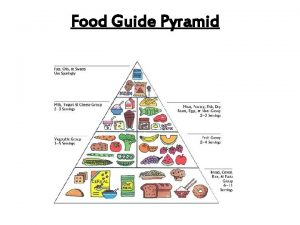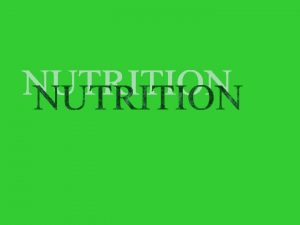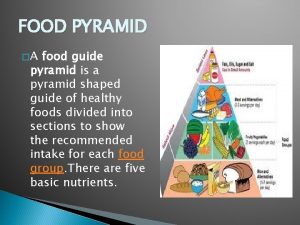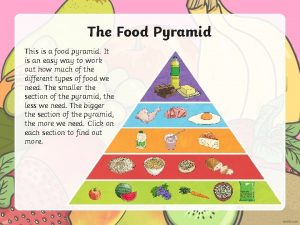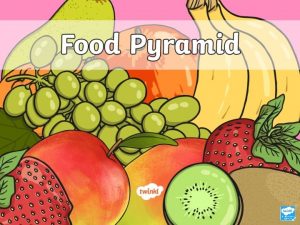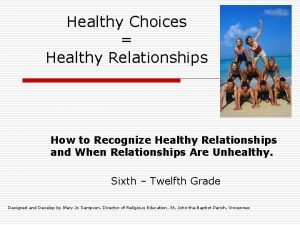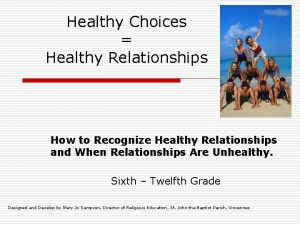FOOD PYRAMID Make healthy food choices Look after














- Slides: 14

FOOD PYRAMID

Make healthy food choices • Look after yourself. Your health is important, and it’s affected by what you eat. • Help with preparing the family meals. You could even have one night a week when you cook for the whole family. • As often as you can, eat meals with your family and whānau. • Lead by example – encourage your family and whānau and friends to make healthy food choices. • Eat three meals every day plus two or three healthy snacks during the day. You also need to drink plenty of water. • Always take time to eat a healthy breakfast – so you have energy to start the day.

Eat many different foods • • • Eat a variety of foods from these four food groups every day: vegetables and fruit breads and cereals milk and milk products lean meats, chicken, seafood, eggs, legumes*, nuts and seeds. * Legumes include cooked dried beans, peas and lentils.


Vegetables and fruit • Provide carbohydrate, vitamins and minerals, fibre and are low in fat. • • • Eat them with most meals. Great snack food. How much do I need? At least 3 servings of vegetables and 2 servings of fruit every day. Eat many different coloured vegetables and fruit: tomato or strawberry; broccoli or kiwifruit; carrot or mandarin; eggplant or plum; potato or pear.

What is one serving? • • • 1⁄2 cup of cooked vegetables, eg, broccoli, peas, corn, spinach, pūhā (50– 80 g) 1⁄2 cup of salad (60 g) 1⁄2 cup of fresh fruit salad (120 g) 1 medium potato, or kūmara (135 g) 1 carrot (75 g) or tomato (80 g) 1 apple, pear, banana or orange (130 g) 2 small apricots or plums (100 g) Dried fruit and fruit juice are not recommended because they contain a lot of sugar. If you do include them, have only one serving of dried fruit or one serving of juice each day. One serving is 25 g of dried fruit (such as 3 dates or 2 tablespoons of raisins) or 1 cup of diluted fruit juice (1/2 a cup of water plus 1/2 a cup of juice).

Breads and cereals They also include rice and pasta. • • They provide carbohydrate, which can be an important source of energy and fibre, and some vitamins and minerals (especially wholegrain breads and cereals). • A great source of energy for growth, sport and fitness. • If you’re hungry, fill up on these foods. They will keep you full for longer than biscuits, cakes or sweets. • • How much do I need? At least 6 servings every day – if you’re very active, you may need more. What is one serving? 1⁄2 cup muesli (55 g) or porridge (130 g) 1 cup cornflakes (30 g) 1 cup of cooked pasta or rice (150 g) 1 medium slice of bread (26 g), roll (50 g), pita pocket or tortilla (50– 80 g) 2 breakfast wheat biscuits (34 g)

Milk and milk products • • • They include milk, cheese and yoghurt. They provide energy, protein, fat and most vitamins and minerals, including calcium. You need high-calcium foods to build strong bones. Choose low-fat milk (yellow or green top) for extra calcium. Try milk, cheese and yoghurt as snacks. How much do I need? At least 3 servings every day. Choose low-fat options. What is one serving? 1 cup of low-fat milk (250 ml) 1 pottle of low-fat yoghurt (150 g) 2 slices of cheese (40 g) or 1⁄2 cup of grated cheese

PROTEIN • Lean meats, chicken, seafood, eggs, legumes*, nuts and seeds • All contain protein, which your body needs to grow. • Also contain fat and many different vitamins and minerals – especially iron, which is important for your blood and brain. • Your body easily uses the iron from meat, chicken and seafood. To help use the iron from legumes, eat fresh, vitamin C-rich vegetables and fruit at the same time, including kūmara, broccoli, tomatoes, oranges and kiwifruit. • Limit processed meats, such as luncheon, salami, bacon and ham as they are usually high in fat and/or salt. • • * Legumes include cooked dried beans, peas and lentils. How much do I need? At least 2 servings every day. Vegetarians – at least 3 servings of legumes, nuts or seeds.

What is one serving? • • • 1/3 cup of nuts or seeds (50 g) 3⁄4 cup of mince or casserole (195 g) 3⁄4 cup baked beans 3⁄4 cup of tofu (200 g) 1 medium fillet of fish or steak (100– 120 g) 1 medium pāua or kina (100– 120 g) 1 egg 2 slices of cooked lean meat (100 g), eg roast lamb, chicken or pork 2 chicken drumsticks or 1 chicken leg

Vegetarians • Vegetarians need food with lots of iron such as wholegrain cereals, legumes, dried fruits and dark green leafy vegetables. To help your body absorb the iron in these foods, eat fresh, vitamin C-rich vegetables and fruit with them. • If you don’t eat cheese, milk or eggs, you need to get protein from foods such as tofu and legumes. You also need to drink soy milk that has added calcium and vitamin B 12. • (See the pamphlet Eating for Healthy Vegetarians – Code HE 1519. )

Food Pyramid

Healthy snacks • Snacks help provide the extra energy you need for growth and physical activity. If you are going to be out and about, take snacks with you. Choose healthy snacks that are low in fat, salt and sugar, such as: • bread, bread rolls, bagels, rēwena and pita breads or French sticks. Try some wholegrain varieties and have them with your favourite low-fat fillings • • • crackers, fruit buns, scones, fruit bread, pancakes, popcorn (try popping your own) pasta and rice breakfast cereals with low-fat milk/yoghurt low-fat yoghurt, plain or flavoured low-fat milk fresh fruit – whole, with yoghurt, blended in a home made smoothie or with a slice of cheese vegetable sticks together with a low-fat dip or spread (hummus, cottage cheese or yoghurtbased dips) • reheated leftovers, for example, stews, soups and vegetables (such as potato, taro, pumpkin or kūmara).

 Left right look
Left right look When making smart food choices what question
When making smart food choices what question Nutrition and productivity
Nutrition and productivity After me after me after me
After me after me after me If anyone desires to come after me
If anyone desires to come after me Healthy soil healthy life poster ideas
Healthy soil healthy life poster ideas Healthy forests healthy communities poster contest
Healthy forests healthy communities poster contest Healthy nurse healthy nation
Healthy nurse healthy nation Junk food vs healthy food project
Junk food vs healthy food project Role play on healthy food and junk food
Role play on healthy food and junk food Introduction of role play
Introduction of role play Healthy food vs junk food
Healthy food vs junk food Junk food examples
Junk food examples Food introduction essay
Food introduction essay Choices producers make
Choices producers make








